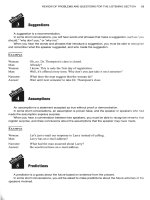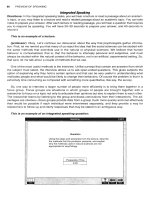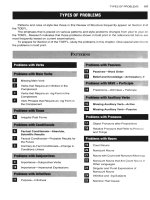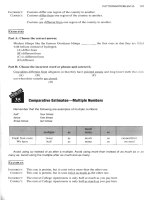Tài liệu How to prepare for the toefl part 69 ppt
Bạn đang xem bản rút gọn của tài liệu. Xem và tải ngay bản đầy đủ của tài liệu tại đây (1.51 MB, 10 trang )
MODEL
TEST 9-NEXT GENERATION
TOEFL
683
Reading
Section
This is the Reading Section of the Next Generation TOEFL Model Test. This section tests your ability
to understand reading passages like those in college textbooks. There are three passages. After each pas-
sage, you will answer twelve or thirteen questions about it. Most questions are worth one point, but one
question in each passage is worth more than one point. You will have
25
minutes to read each passage
and answer the comprehension questions. You may take notes while you read. You may use your notes
to answer the questions. Choose the best answer for multiple-choice questions. Follow the directions on
the page or on the screen for computer-assisted questions. Click on
Next
to go to the next question.
Click on
Back
to return to the previous question. You may return to previous questions in the same read-
ing passage, but after you go to the next passage, you may not return to a previous passage.
A
clock on
the screen will show you how much time you have to complete each passage.
Independent Reading
1:
"Symbiotic Relationships"
1.
(C) In the context of this passage,
derives
means "obtains." Choices (A), (B), and (D)
are not accepted meanings of the word
derives.
2.
(C) "Parasitism is a relationship in which
one organism, known as the parasite, lives in
or on another organism, known as the host,
from which it [the parasite] derives nourish-
ment." The pronoun
it
does not refer to
Choices
(A),
(B),
or (D).
3.
(A) In the context of this passage,
relatively
means "comparatively." Choices (B), (C),
and
(D)
are not accepted meanings of the
word
relatively.
4.
(C)
Choice (C) is a paraphrase of the state-
ment. Choices (A), (B), and (D) change the
meaning of the statement.
5.
(A) In the context of this passage,
tolerate
means "permit." Choices (B), (C), and (D)
are not accepted meanings of the word
tolerate.
6.
(D)
"Parasites that live on the surface of their
hosts are known as
ectoparasites."
Choice
(A)
is not correct because mold and mildew
are examples of ectoparasites, not
a
descrip-
tion of the way they survive. Choice (B) is
not correct because it refers to endoparasites,
not ectoparasites. Choice (C) is not correct
because bacteria are an example of endo-
parasites.
7.
(A) "There are many examples of commen-
sal relationships. Many orchids use trees as a
surface upon which to grow." Choice (B)
refers to a parasite, not a member of a com-
mensal relationship. Choice (C) refers to a
member of a mutualistic relationship. Choice
(D) refers to a parasite.
8.
(C) In the context of this passage,
crctually
means "really." Choices,(A)
,
(B)
,
and (D) are
not accepted meanings of the word
actually.
9.
(B)
". . .
the species can exist separately but
are more successful when they are involved
in a mutualistic relationship. Some species
of
Acacia.
. .
.
"
Choice
(A)
is not correct be-
cause the ants could exist separately but they
are more successful living in the
Acacia
trees. Choice (C) is not correct because the
example refers to a specific plant
[Acacia]
and animal [ant], not to all plants and ani-
mals. Choice (D) is not correct because mu-
tualism is a solution, not a problem.
10.
(C)
".
. .
have bacteria that live in their roots.
.
.
.
The bacteria do not cause disease but
provide the plants with nitrogen-containing
molecules that the plants can use for
growth." Choice (B) is not correct because
the plants use the nitrogen supplied by bacte-
ria for growth. Choice (D) is not correct be-
cause the nodules are helpful, not harmful.
Choice (A) is not mentioned and may not be
concluded from information in the passage.
11.
(A) Pronoun reference is a transitional de-
vice that connects the insert sentence with
the previous sentence. The two sentences are
related by the reference to "molds" and
"mildews" in the previous sentence and the
pronoun "they" in the insert sentence.
12.
(A) Because the passage is about the relation-
ship between organisms,
it
may
be
concluded
684
EXPLANATORY ANSWERS AND AUDIO SCRIPTS
that the passage would most probably
appear in the chapter, "Environment and
Organisms." Choices
(B),
(C), and (D) would
probably not include a passage on symbiosis.
13.
(A)
(C)
(E)
summarize the lecture. Choice
(B) is true, but it is a minor point mentioned
as an example of a parasitic relationship.
Choice (D) is true, but it is a minor point
mentioned as an example of a mutalistic re-
lationship. Choice
(F)
is true, but it is a
minor point mentioned as an example of a
commensal relationship.
lndependen
t
Reading
2:
"Civilization"
1.
(B) " Neolithic settlements were hardly
more than villages. But as their inhabitants
mastered the
art
of farming, they gradually
began to give birth to more complex human
societies [civilizations]." Choice (A) is not
correct because the Neolithic settlements
preceded civilizations. Choice (C) is not cor-
rect because agriculture is mentioned as a
cause of the rise in complex cultures, not as a
definition of civilization. Choice (D) is not
correct because the population centers in-
creased in size as civilizations grew, but
other basic characteristics had to be present
as well.
2.
(B) "Although copper was the first metal to
be utilized in producing tools, after 4000
B.c.,
craftspeople in western Asia discovered that
a combination of copper and tin produced
bronze, a much harder and more durable
metal than copper. Its [bronze's] widespread
use has led historians to speak of a Bronze
Age.
. . ."
The pronoun
its
does not refer to
Choices (A), (C), or
(D).
3.
(B) "As wealth increased, such societies
began to develop armies and to build walled
cities." Choices (A), (C), and
(D)
may be
logical, but they are not mentioned and may
not be concluded from information in the
passage.
4.
(C)
In the context of this passage,
hardly
means "barely." Choices (A),
(B),
and (D)
are not accepted meanings of the word
hardly.
5.
(D)
Because the author states that Neolithic
towns were transformed, it may be conclud-
ed that they are mentioned to contrast them
with the civilizations that evolved. Choice
(A)
is not correct because a Neolithic town
does not qualify as a civilization. Choice
(B)
is not correct because writing systems were
not part of Neolithic settlements. Choice (C)
is not correct because Neolithic settlements
were referred to as villages, and no argument
was made for the classification.
6.
(B)
".
.
. .
a new social structure
. . .
[included]
lungs
and
an upper class
.
. .
free people
. .
.
and a class of slaves.
.
. .
"
Choice (A) is not
correct because it does not include free peo-
ple. Choice (C) is not correct because it does
not include free people. Choice (D) is not
mentioned and may not be concluded from
information in the passage. The new struc-
ture described is based on economics, not
education.
7.
(A) Choice (A) is a paraphrase of the state-
ment. Choices
(B),
(C), and (D) change the
meaning of the statement.
8.
(A) In the context of this passage,
crucial
means "fundamental." Choices
(B),
(C), and
(D) are not accepted meanings of the word
crucial.
9.
(B) In the context of this passage,
prominent
means "important." Choices (A), (C), and
(D) are not accepted meanings of the word
prominent.
10.
(B)
"A number of possible explanations of
the beginning of civilization have been sug-
gested." Choice (A) is not correct because
scholars do not agree on one explanation.
Choice (C) is not correct because trade
routes are not mentioned in paragraph
4.
Choice
(D)
is not correct because coinci-
dence is not mentioned as one of the possible
explanations.
11.
(C)
Choice (A) is mentioned in paragraph
4,
sentence
9.
Choice (B) is menticned in para-
graph 4, sentence
8.
Choice (D) is mentioned
in paragraph 4, sentence
6.
12.
(B)
A
rhetorical question is a question that is
asked and answered by the same speaker.
Response is a transitional device that con-
nects the insert sentence with the previous
rhetorical question. Choices (A), (C), and
(D)
do not include transitional devices that
connect the insert sentence with the sen-
tences marked in the passage.
MODEL
TEST 9-NEXT GENERATION TOEFL
685
13.
(B)
(E)
(F)
summarize the passage. Choice
(A) is true, but it is a minor point that is men-
tioned as an example in the characteristic of
a class structure. Choice (C) is not men-
tioned in the passage. Choice (D) is not men-
tioned in the passage.
Independent Reading
3:
"The Scientific
Method"
1.
(B) In the context of this passage,
obvious
means "clear." Choices (A), (C), and (D) are
not accepted meanings of the word
obvious.
2.
(B)
"
.
.
.
our interpretations of facts often are
based on beliefs about the world that others
might not share. For example
. .
.
that the
Sun rises
.
.
.
[is] an idea that might not have
been accepted by ancient Egyptians.
.
. .
7,
Choice (A) is not correct because the rota-
tion might not have been accepted by ancient
Egyptians. Choices (C) and
(D)
are not men-
tioned and may not be concluded from infor-
mation in the passage.
3.
(C)
In the context of this passage,
essentially
means "ba~ically.'~ Choices (A),
(B),
and (D)
are not accepted meanings of the word
es-
sentially.
4.
(A) In the 'context of this passage,
flawed
means "not perfect." Choices (B), (C), and
(D) are not accepted meanings of the word
flawed.
5.
(B) Choice (B) is a paraphrase of the state-
ment. Choices (A), (C), and
(D)
change the
meaning of the statement.
6.
(B)
". .
.
its [the Ptolemaic model's] predic-
tions didn't quite match actual observa-
tions-a key reason why the Earth-centered
model of the universe finally was discard-
ed." The pronoun
its
does not refer to Choic-
es (A), (C), or (D).
7.
(A) 'Therefore, even well-established theo-
ries must be subject to continuing challenges
through further observations and experi-
ments." Choice (C) is not correct because a
theory that is generally accepted by the sci-
entific community would have to be subject
to scientific observation and experimenta-
tion. Choices (B) and (D) are not mentioned
and may not be concluded from information
in the passage.
8.
(C)
". .
.
Kepler
. . .
tested his model against
observations that had been made previously,
rather than verifying new predictions.
.
.
."
Choice
(A)
is not correct because the predic-
tions do not verify a model. Predictions must
be verified by the model. Choices (B) and
(D) are not mentioned and may not be con-
cluded from information in the passage.
9.
(D)
In the context of this passage,
plenty
means "numerous." Choices
(A),
(B),
and
(C) are not accepted meanings of the word
plenty.
10.
(D)
Choice (A) is mentioned in paragraph 2,
sentence
2.
Choice (B) is mentioned in para-
graph
2,
sentence
8.
Choice (C) is mentioned
in paragraph 2, sentence
5.
11.
(A) Because the Ptolemaic model "didn't
quite match actual observations.
.
.
.
"
it
may
be concluded that a model does not always
reflect observations. Choice
(B)
is not cor-
rect because theories are more firmly estab-
lished than models. Choice (C) is not correct
because a theory can never be "true beyond
all doubt." Choice (D) is not correct because
"a model must be continually challenged
with new observations or experiments."
12.
(C)
Paraphrase is a transitional device that con-
nects the insert sentence
with
a previous sen-
tence.
"
. . .
our [cultural] interpretations of
facts"
in
a
previous sentence is a paraphrase of
"cultural orientation" in the insert sentence.
Choices (A), (B), and (D) do not include transi-
tional devices that connect the insert sentence
with the sentences marked in the passage.
13. (A)
(C)
(E)
summarize the lecture. Choice
(B)
is true, but it is a minor point mentioned
in reference to the fourth and final step of the
method. Choice (D) is true, but it is men-
tioned after the discussion of the steps in the
scientific method. Choice
(F)
is not men-
tioned in the passage.
Writing
Section
This is the Writing Section of the Next Genera-
tion TOEFL Model Test. This section tests your
ability to write essays in English. During the test,
you will write two essays. The independent essay
usually asks for your opinion about a familiar
topic. The integrated essay asks for your
686
EXPLANATORY ANSWERS AND AUDIO SCRIPTS
response to an academic reading passage, a lec-
ture, or both. You may take notes as ypu read and
listen. You may use your notes to write the es-
says. If a lecture is included, it will be spoken,
but the directions and the questions will be writ-
ten.
A
clock on the screen will show you how
much time you have to complete each essay.
Independent Writing:
''Study
in the
United States"
Question:
You are planning to study in the United States.
What do you think you will like and dislike about
this experience? Why? Use specific reasons and
details to support your answer.
Outline
Like
Improve language proficiency
Participate in culture
College courses
Dislike
Miss family
Rely on fast food
Compete with Americans
I
Like
I
Participate
in
culture
Improve College
language courses
proficiency
Example
Essay
cy. There are idioms and words that are best
learned within the context of real conversations
with native speakers. I also look forward to being
a participant in a new culture. At the end of my
stay in the United States, I hope that I will under-
stand American culture in a different and deeper
way than is possible when the information is de-
rived from only movies and books. In addition,
I
am
excited about studying on an American cam-
pus.
I
expect the college courses to be challeng-
ing, and I am eager to learn about the latest tech-
nological advances in my field of study.
I
am realistic about the disadvantages of for-
eign study, however.
I
know that
I
will miss my
family very much. It will be too expensive to re-
turn to my country to spend holidays with them,
and
I
will be very lonely during the times when
I
know that they are gathered for special celebra-
tions. Another aspect of the experience that I do
not look forward to is the reliance on fast food
that is so typical of American college students.
Pizza, hamburgers, and other junk foods are eas-
ier to find and prepare than the meals that I enjoy
in my country, but they aren't as good, and they
probably aren't as healthy. Finally,
I
imagine that
my life will be very stressful because I will be
competing with students who know the language
of the classroom and are accustomed to the ex-
pectations that American professors have for
their students. I am a competitive person by
nature, and I am apprehensive about my ability
to compete with my classmates.
Once
I
am in the United States,
I
will no doubt
find many other opportunities to take advantage
of and many challenges that
I
must confront.
Nevertheless,
I
expect my experience to be over-
whelmingly positive, and I intend to see the
lessons in both adventures and adversity.
I
f!$y
1
I
cO~~~te
I
Integrated Writing: '6Pro~lem Solving"
Americans
Audio
Narrator: Now listen to a lecture on the same
topic as the reading passage on page
477.
Living abroad provides many opportunities
and challenges. When I study in the United
Professor:
States, I look forward to making friends with
Now that you've read the article on problem
Americans. By getting to know people,
I
will be
solving, let's talk about the role of breaks. We all
able to improve my English language proficien-
know that taking a break is a good strategy for
MODEL
TEST 9 NEXT GENERATION TOEFL
687
solving a problem, but how does a break really
influence the solution? Well, some researchers
feel that rest allows the brain to analyze the prob-
lem more clearly. We're advised to "sleep on it"
when a problem is difficult to solve. Okay, but
what if there's some type of
incubation
efSect
during sleep that allows the brain to continue
working on a solution? Here's what I mean. F. A.
Kekule was puzzled by the structure of benzene.
One night, he dreamed about a snake biting its
tail while whirling around in a circle. And when
he awoke, it occurred to him that the carbon
atoms of benzene might be arranged in a ring. He
attributed the solution of the problem directly to
the dream. But Kekule's experience and others
like it present researchers with a dilemma be-
cause there's disagreement about whether uncon-
scious mental activity exists. Were the dreamers
really asleep or were they relaxed but awake
when they solved the problem?
Two explanations have been proposed to ex-
plain why a break supports problem solving
while we're awake. One possibility is that during
the break, information may appear that provides
a solution. For example, Buckminster Fuller was
looking at a triangle when he saw the structure of
multiple triangles as the solution for constructing
a geodesic dome. Of course, another possibility
is much more simplistic. It could be that the
value of taking a break is as basic as interfering
with an ineffective pattern of thinking. By focus-
ing on something else, we may return to the
problem in a different frame of mind and think
about it in a different, and more productive, way.
Question:
Summarize the main points in the lecture, refer-
ring to the way that they relate to the reading pas-
sage on page
477.
Outline
Sleeping
Rest to function at higher capacity
"Incubation effect7'-Kekule structure benzene
''Functional fixedness" released
Waking
Input during break-Fuller geodesic dome
Interruption unsuccessful process
Different "mental set"
Breaks
r'-l
Sleeping
Incubation
effect
Rest
Functional
fixedness
structure
Waking
rw-l
lnterruplion
Fuller
geodesic
Example
Essay
Although researchers do not agree about the
way that a break contributes to problem solving,
it is clear that breaks during sleeping hours and
those that we take during waking hours are both
helpful. The value of sleep may be related to the
brain's requirement for rest in order to function at
a higher capacity. On the other hand, it is possible
that there is an "incubation effect," that is, that the
brain continues to problem solve at a different
level of consciousness during a sleep break. For
example, Kekule had insight into the structure of
benzene during a dream. Although researchers
are not in agreement as to the level of uncon-
scious activity of dreamers, and some argue that
dreamers who solve problems are not really
asleep, it remains that the sleep break was help-
ful. It may even be that "functional fixedness" de-
scribed in the text is somehow released in sleep so
that preconceived notions are less limiting.
In contrast, breaks during waking hours ap-
pear to be more straightforward. Sometimes
input during the break period will contribute to
the solution. For example, Fuller's inspiration for
the geodesic dome occurred while he was look-
ing at a triangle during a break. However, merely
interrupting an unsuccessful problem-solving
process could be helpful. By taking a break. we
may be more willing to abandon a strategy that is
not working, or, as the text states, we return to
the problem with a different "mental set."
SCORE
ESTIMATES
SCORE CORRESPONDENCE PROCEDURE
691
It is not possible for you to determine the exact score that you will receive on the TOEFL. There are
three reasons why this is true. First, the testing conditions on the day of your official TOEFL will affect
your score. If you are in an uncomfortable room, if there are noisy distractions, if you are upset because
you almost arrived late for the test, or if you are very nervous, then these factors can affect your score.
The administration of a Model Test is more controlled. You will probably not be as stressed when you
take one of the tests in this book. Second, the Model Tests in the book are designed to help you practice
the most frequently tested item types on the official TOEFL. Because they are constructed to teach as
well as to test, there is more repetition in Model Tests than there is on official TOEFL tests. Tests that
are not constructed for exactly the same purposes are not exactly comparable. Third, the TOEFL scores
received by the same student will vary from one official Computer-Based TOEFL examination to anoth-
er official Computer-Based TOEFL examination by as many as
20
points, even when the examinations
are taken on the same day. In testing and assessment, this is called a standard error of measurement.
Therefore, a TOEFL score cannot be predicted precisely even when two official tests are used.
But, of course, you would like to know how close you are to your goal. To do that, you can use the
following procedure to estimate your TOEFL score. An estimate is an approximation. In this case, it is a
range of scores.
1.
Use the charts on the following pages to determine your percentage scores for each section of
the TOEFL.
2.
Determine the total percentage score for the TOEFL.
Listening Section
=
one-third the total
Structure Section
=
one-sixth the total
Reading Section
=
one-third the total
Writing Section
=
one-sixth the total
3.
Use the Score Correspondence Table to estimate an official TOEFL score.
692
SCORE
ESTIMATES
Listening Section
Number Correct Percentage Score
Structure Section
Number Correct Percentage Score
SCORE CORRESPONDENCE PROCEDURE
693
Reading Section
Number Correct Percentage Score
Writing Section
Scaled Score Percentage Score
694
SCORE ESTIMATES
Score Correspondence Table
Progress Chart
Percentage Scores
Listening Structure Reading Writing
=
Total
=
Score Ranges
% %
%
%
One
Two
Three
Four
Five
Six
Seven
Eight









